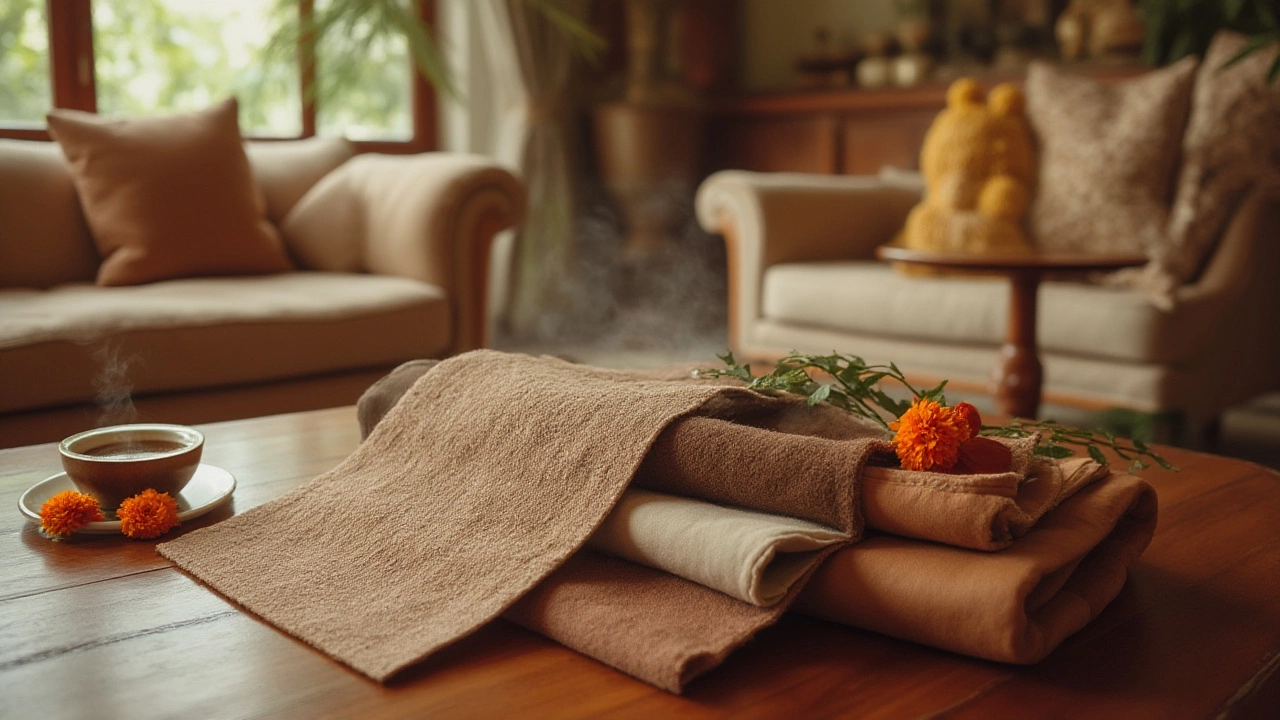They're everywhere, from family game nights to binge-watching marathons: couches take a beating, but not all survive beyond a few years of daily action. Some seem to crumble within months, while others get handed down for generations. Why? It's not just luck. The couch you choose—and what it's made of—decides whether you'll be shopping for a replacement soon, or bragging about how your sofa is older than social media.
The Real Secret Behind Super-Lasting Couches
People love to debate leather versus fabric, but the truth is, permanence starts where you can't see: the frame. You know those sad, sagging couches on the curb? Most failed because the frame gave up first. Hardwoods like kiln-dried oak, maple, or ash are the MVPs here, staying tough under weight and stress year after year. Kiln-drying is more than sales fluff: it zaps moisture from the wood, making it less likely to warp or crack. If you can find a couch with a frame made from plywood, check the layers—9-ply or more is serious business, while anything with visible knots, stapled corners, or particleboard spells trouble.
What about joints? Look for words like “double dowel,” “corner block,” “mortise and tenon,” or metal screws—not just glue and staples. These joinery techniques keep creaking and sudden collapses out of your future. Here’s a quirky fact: Many 1950s couches still going strong today used these exact methods. Cheap knockoffs that use only glue are why so many couches call it quits early.
Springs matter, too. Sinuous (“S”-shaped) steel coils dominate the market. They do the job but tend to sag after a heavy few years. For luxury and resilience, eight-way hand-tied springs are king. Yes, they cost more, but they can take decades of family wrestling matches and still snap back for movie night.
Let's look at the handy table below to compare popular couch frame and suspension systems:
| Component | Best Material/Method | Average Lifespan | Why It Lasts |
|---|---|---|---|
| Frame | Kiln-dried hardwood (oak, maple, ash) | 15-20 years+ | Won't warp, crack, or bend |
| Frame (Budget) | Plywood (9-ply+) | 8-12 years | Strong layering, resists breaking |
| Suspension | Eight-way hand-tied springs | 20 years+ | Resists sagging, handles weight |
| Suspension (Standard) | Sinuous ‘S’-springs | 7-10 years | Affordable, average performance |
So next time you’re tempted by that flashy, bargain sofa in the store, dig for details about its skeleton. The showy fabrics and soft cushions don’t mean much if the frame’s destined for the landfill in three years.
Choosing the Right Upholstery: Leather, Polyester, and Beyond
Now, the outside of your couch is where the battle with life happens: spilled soda, muddy paws, wild toddlers, you name it. The big rivalry is usually leather versus fabric, and here’s where myths pile up. Not all leather is created equal; for serious long-term performance, look for full-grain or top-grain leather. These types come from the thickest part of the hide, resisting cracks, fading, and those weird peelings that turn lounges into eyesores. Want numbers? Well-maintained full-grain leather sofas regularly outlive fabric options, many topping 20-25 years.
Fabric, though, isn’t out of the race. Performance fabrics—think solution-dyed acrylic, polyester microfibers, or even Crypton—are designed for mayhem. They shrug off stains, dog hair, and feel soft without wearing thin. Cheap cotton or blends, especially if loosely woven, don’t have the battle record. Expect pilling, sun-fading, or stretched-out patches in under 5 years unless you baby them. If you want a family couch that won’t look like a scratching post, consider microfiber: it’s legendary for toughness, with many couches lasting over a decade even in wild households.
You’ll also see linen, wool, velvet, and synthetic blends in showrooms. Linen is classy but fragile; it stains and wrinkles faster than you can say 'take off your shoes.' Velvet? Gorgeous, but needs regular attention to avoid crushing. Wool is sturdy—natural stain resistance, minimal pilling—but can get pricy. Synthetics like polyester or nylon, especially blended with natural fibers, tend to resist wear better than pure cotton.
Look for upholstery labeled "double rub count"—a measurement of how many times fabric can be rubbed before it wears out. For home couches, hunt for a number above 15,000 double rubs. Commercial-grade fabrics hit 30,000 or more, so if you’ve got six kids, two dogs, and a standing invitation to the neighbor’s soccer team, aim high.
Here's a breakdown of sofa fabric types and their life expectancy:
| Fabric/Upholstery | Lifespan (Well Cared-For) | Best For | Watch Out For |
|---|---|---|---|
| Full-grain leather | 20-25 years | Longevity, pets, elegance | Price, needs occasional care |
| Top-grain leather | 15-20 years | Style, strong use | Still pricy, less softens with age |
| High-performance microfiber | 10-15 years | Families, pets, spills | Some feel less breathable |
| Standard cotton/poly blend | 5-8 years | Low-traffic rooms | Wrinkling, less stain resistance |
| Linen | 3-5 years | Style, formal sitting | Stains, snags easily |
Pro tip: Ask about upholstery cleaning codes (W = water-based, S = solvent, WS = either, X = vacuum only) before you commit. Spot a lot of ‘X’ codes? Probably not the best idea for a potato chip-and-dip household.

Cushion Construction: Foam, Down, and Springs That Won't Quit
People complain more about saggy, flat cushions than anything else. It’s what separates the one-year wonder from the decade-long champion. Here’s an easy test: pick up a sofa cushion and squeeze—if it doesn’t spring back or feels like a marshmallow, it won’t go the distance. The *strong* secret weapon here is high-density polyurethane foam (density rating of 1.8 lbs/cu.ft. or higher). Anything lower compresses and stays that way, while high-density keeps its bounce for thousands of TV hours.
Premium couches sometimes upgrade the core with coil springs inside the cushions. This is a little like your mattress—a core of tiny springs hugged by foam or down. It means better shape retention, less drooping, and that classic, supportive feel. Down-wrapped cushions feel like heaven, but if there’s not enough foam in the mix, you’ll be doing a bunch of fluffing—and they cost more. Full-down cushions? Forget it unless you want to babysit your seat every day.
Sofa manufacturers sometimes cut costs by using “shredded” or “recycled” foam pieces instead of a single solid block. This stuff pushes out of shape fast, leaving saggy, bumpy places. Always check that seat cushions are reversible—flipping and rotating slows the flattening disaster. Zippered covers are handy, letting you replace foam or batting if things ever get rough (which is a heck of a lot cheaper than sofa shopping again).
Take a look at the following table for a fast look at common cushion types:
| Type | Benefits | Typical Lifespan | Best Use |
|---|---|---|---|
| High-density foam (1.8+ lb/cu.ft.) | Resilient, shape-holding, affordable | 10-15 years | Busy homes, heavy use |
| Coil spring in foam | Very durable, keeps its shape | 12-18 years | Premium, luxury couches |
| Down-wrapped foam | Ultrasoft, cozy | 8-12 years | Comfort seekers, less frequent use |
| All polyester batting | Cheap, holds brief shape | 2-5 years | Temporary use, guest rooms |
| Recycled/shredded foam | Low cost, but prone to lumping | 1-3 years | Low-budget, short-term |
Some quick-fire maintenance tips? Vacuum under those cushions every couple of weeks to chase crumbs and stop friction wear. Rotate every couple of months, not just to "freshen things up," but to make sure every section gets equal wear. Got pets? Grab a furniture brush and try washable throw blankets on high-traffic zones—saves your couch from fur and stains like nothing else.
What Brands and Models Actually Go the Distance?
Here's where things get spicy. There are brands hiding behind fancy advertising, but only a handful consistently get rave reviews for longevity from real-world owners. Think La-Z-Boy, Stickley, Ethan Allen, and even some handmade regional options—you'll see their couches passed between family members, still sturdy after a decade or more. In apartments, folks cheer for IKEA’s KIVIK and EKTORP, which punch way above their price, especially if you swap the standard foam for third-party high-density refills. Few people realize that reupholstering a quality frame can let you change styles without tossing the whole couch, saving cash and landfill space.
Online reviews and user photos are gold. Skip the polished marketing shots—look for couches photographed five or more years in. It's not rare to spot La-Z-Boys and Room & Board models where the fabric shows some love, but the cushions and frame still deliver every day. Check out Reddit’s r/BuyItForLife; people post unfiltered updates on their “indestructible” sofas, and the patterns are obvious: top-tier materials, sturdy frames, and time-tested construction always win. Some sleepers: BenchMade Modern, Joybird, and American Leather make custom options that last, especially when you go for hardwood frames and resilient fabrics.
And warranties? They matter. Solid manufacturers offer ten years on frames over the industry standard of one or two. If the warranty is shorter, it usually means they know the couch is a dice roll. Pay attention to repair and replacement policies—some even send out replacement cushions years later, free or at cost.
- For heavy use: Stickley, Room & Board, La-Z-Boy, Flexsteel
- For great value: IKEA (upgrade cushions!), Article, Joybird
- For pets/kids: Look for models with removable, washable covers (IKEA, Burrow, Lovesac)
- For custom builds: Local upholsterers sometimes offer a better price for a solid hardwood frame than big-box chains, plus you get the exact fabric you crave.
Final pro tip? Before you shell out for fancy cleaning sprays and harsh chemicals, check your sofa’s cleaning code. Hot water—and a gentle hand—does more for a couch’s life than most store cleaners. If possible, keep your couch out of direct sunlight and away from heat vents; fading and brittleness are much bigger threats than most folks realize.
Long story short, the durable couch isn’t a one-size-fits-all deal. Get a hardwood frame, high-performance fabric, and dense foam cushions if you want to brag about your living room’s endurance. Treat it right, and you’ll be the person telling everyone, Yes, this is the same couch as when we moved in. It just won’t quit.
